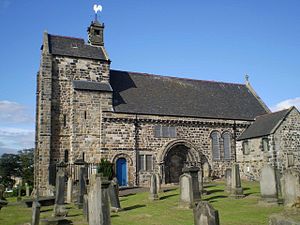Kirkliston
| Kirkliston | |
|---|---|
 Kirkliston Parish Church |
|
| Kirkliston shown within Edinburgh | |
| Population | 3,386 (2011) |
| Civil parish |
|
| Council area | |
| Lieutenancy area |
|
| Country | Scotland |
| Sovereign state | United Kingdom |
| Post town | KIRKLISTON |
| Postcode district | EH29 |
| Dialling code | 0131 |
| Police | Scottish |
| Fire | Scottish |
| Ambulance | Scottish |
| EU Parliament | Scotland |
| UK Parliament | |
| Scottish Parliament | |
Kirkliston is a small town and parish to the west of Edinburgh, Scotland, historically within the county of West Lothian. It lies on high ground immediately north of a northward loop of the Almond, on the old road between Edinburgh and Linlithgow (the B9080, now cut off by Edinburgh Airport), having a crossroads with the road from Newbridge to Queensferry and beyond to Fife (the B800). The B800 is variously named Path Brae, High Street, Station Road, and Queensferry Road as it passes through the town. The B9080 is named Main Street and Stirling Road as it passes through.
The ancient name of the town was Liston, derived from the British llys meaning court or manor, and the Old English tun meaning town or farmstead. Britons would have been the earliest inhabitants of the area, with Angles later arriving from Northumberland. In the 13th century the name was recorded as Temple Liston, referring to the Knights Templar, who possessed the Barony of Liston at the heart of the parish. The prefix Kirk (church) first appears in the 14th century, after the Knights Templar had been disbanded and their lands given to the Knights Hospitaller. The Hospitallers are commemorated by the Maltese Cross in the arms of the community council, which were granted in 1991.
Kirkliston was the location of the first recorded parliament in Scottish history; the Estates of Scotland met there in 1235, during the reign of Alexander the Second. In June 1298 Edward Longshanks made camp at the town on his way to fight Sir William Wallace at the Battle of Falkirk. Tradition states that he planted his standard at Greig's Hill, now within the Gateside housing estate. A violent quarrel broke out in the camp between Edward's English and Welsh forces, and eighteen ecclesiastics were killed. Clerics' Hill is named in commemoration of them. When the Welshmen announced their intention to defect to the Scots, Edward replied "let my enemies go and join my enemies; I trust that in one day I shall chastise them all."
...
Wikipedia

